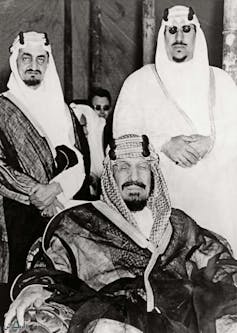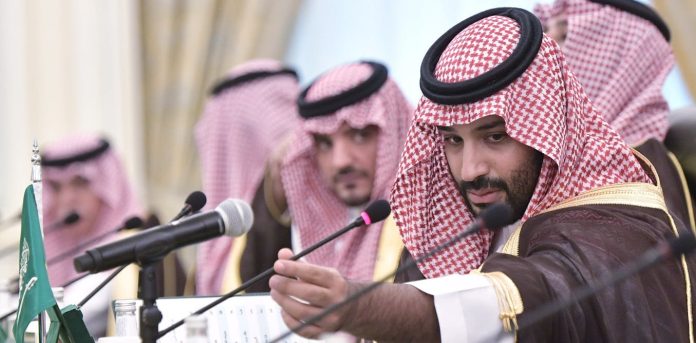Has a new royal order in Saudi Arabia revealed the future line of succession?
Saudi Arabia’s King Salman issued a royal order on August 8 allowing the cabinet to be convened in the absence of both him and his prime minister and crown prince, Mohammed bin Salman.
Such a meeting will be headed by the most senior cabinet member from among the descendants of King Abdul Aziz AlSaud, the founding father of the Saudi state as we know it today.
This royal order is a politically significant development. Since Mohammed bin Salman was elevated to the post of crown prince in 2017, and then to prime minister five years later, the administratively and politically critical positions of deputy crown prince and deputy prime minister have remained vacant.
The vacancies have made it difficult to ascertain the third most powerful person within the Saudi decision-making structure, or to speculate about the possible candidates.

The decision-making dynamics within the Saudi Kingdom have long been a complex affair. King Saud, the eldest son of and successor to Abdul Aziz, was forced to abdicate in 1964 following a mutual accord between Saudi royalty and the religious elite.
His attempts to centralise power among his own sons, fickle spending habits and risky foreign policy ventures compelled Saud’s half-brother and crown prince, Faisal, to assemble a family coalition to confront and depose him.
Faisal became the king after Saud’s removal and enacted a new system of governance in which power was distributed among the different sons of Abdul Aziz who partnered in his coup. The intention was to avoid power being concentrated in one sub-section of the family.
This horizontal distribution of power led to the emergence of an institutional fiefdom culture. Each prince in charge of a government department or organisation treated it as his personal fief and used it to increase his political influence by cultivating networks of patronage.
This gradually established a power hierarchy within the Saudi royal family. A group of more than 30 half-brothers below the king and crown prince emerged who were considered as future contenders to the Saudi throne based on their seniority, maternal descent and the political importance of the institutional fiefdoms they controlled.
Against this backdrop, the appointment of Prince Fahd as the second deputy prime minister (the crown prince is ordinarily the first deputy) of the Kingdom in 1967 was a significant development. At that time, there was no official position of a deputy crown prince and thus no formal entry into the line of succession.
But Fahd’s stature as interior minister, as well as being the eldest among the seven sons Abdul Aziz had with Hussa Bint Ahmed Al Sudairi, cemented his path to the throne. Fahd became king in 1982 after the death of his elder half-brother and reigning king, Khalid.
This dynamic dictated the appointment of successive second deputy prime ministers. They were either part of a strong band of brothers, as was the case with the Sudairi seven, or were supported by the reigning king, influential family groups, or held a key portfolio.
Prince Abdullah, who was appointed second deputy prime minister in 1975, is a case in point. Abdullah, who had been one of Faisal’s allies in the coup against Saud, had led the Saudi Arabian National Guard since 1962. He also had maternal links to the powerful Shammar tribe that had, in the past, been a political foe of the Saudi royal family.
Abdullah became king in 2005 after Fahd’s death and nine years later appointed another half-brother, Prince Muqrin, as the deputy crown prince, thus initiating a new formal position in the royal line of succession. Like those before him, Muqrin had held an influential position as intelligence chief – though his appointment was primarily due to his proximity to the king.
But when Abdullah died in 2015, this by now decades-old dynamic whereby political positions became an avenue of competition between half-brothers and their respective allies, was completely altered. Salman came to the throne and, within two years, he had removed two successive crown princes and promoted his own son, Mohammed, to the position.
In the intervening years, Salman and his son have managed to erase the political influence of powerful princes and royal factions through administrative changes and an anti-corruption campaign.
All the king’s men
In this new system, power has become purely the prerogative of the king and his son. This has transformed the position of the Saudi king from being the first among equals (primus inter pares) to the ultimate sovereign (ultimum imperium).
However, the recent decision to allow the eldest descendants of Abdul Aziz to preside over cabinet sessions gives us a glimpse into the current royal hierarchy of power below the king and crown prince.
The two eldest royal members of the cabinet, Prince Mansour bin Miteb and Prince Abdul Aziz bin Salman (another of King Salman’s sons), are much older than the crown prince himself. This means they are unlikely to be future candidates for the deputy crown prince role.
So the real candidates are the five remaining young royals who hold critical portfolios within the government. Except the defence minister, Prince Khalid bin Salman (who is one of King Salman’s youngest sons), none of these cabinet members have directly or indirectly inherited their respective ministry from their fathers.
The power hierarchy within the royal family has changed. The personal relationship and proximity between a specific person and the king and the crown prince now increasingly dictates their place within the kingdom’s pecking order.![]()
Umer Karim, PhD Candidate, Department of Politics and International Studies, University of Birmingham
This article is republished from The Conversation under a Creative Commons license. Read the original article.



